Whether big or small, watering is important for every lawn. Some lawns require consistent daily watering, some even twice a day. This can be a lot of work for you, but luckily, installing sprinklers is a good option to automate this task. This way, you can let the sprinklers do the hard work for you as you sit back and enjoy the view.
Sprinklers are available in different shapes and sizes and can be used in various ways, making them the most ideal for both short-term, and long-term uses. Besides regular lawn maintenance, installing sprinklers ensures that your lawn keeps its lush, beautiful, green look.

Table of Contents
What are Sprinklers?
Sprinklers are devices for watering lawns, gardens, landscapes, and other green spaces. They apply water in a regulated manner while ensuring uniform distribution across an area using pipe networks, pumps, valves, and spray heads.
Factors to Consider When Choosing a Type of Sprinkler
Before you purchase a sprinkler for your lawn, there are a few key points to consider to choose the sprinkler best suited for your needs. Dive in to find out.
- The shape of the lawn – Does the targeted lawn have curved or square borders? This is crucial information that will ultimately guide you to find the most preferred sprinkler for your lawn. Whether you have patches on the lawn that should not be sprayed, or you are trying to conserve and minimalize water usage, then go for a sprinkler that has variable spray patterns that will cover your space.
- Size of the target space – Your choice of sprinkler is heavily influenced by the size of the lawn to be watered. For smaller spaces, you can use sprinklers with a short reach. However, for a large lawn space, you will need a sprinkler with a far-reaching jet to cover a wider space, helping to save on the cost of multiple sprinkler installations.
- Supply water pressure – Your options for the best sprinkler reduces with low water pressure. However, if your property has high water pressure, you are free to go for any sprinkler of your choice. Either way, it won’t be the end of the road if you have lower water pressure. You can always reach out to a plumber and have the problem looked at.
- Manual or automatic sprinklers? – Auto-sprinklers have timers. Once you install one, you can set and adjust the timer to water at a certain time(s), and for how long. On the other hand, manual sprinklers do not have timers and need you to be there in person to handle a few tasks like opening the water supply valve.
- The look of the sprinkler – How do you want your sprinklers to look? You may love them popping their heads up a few feet above the ground or installing underground sprinklers that have their jets a few inches above the ground. Which of these do you like the most?

Types of Sprinklers for Your Lawn
Now that you know what sprinklers are and what to consider when choosing one, which sprinkler could best fit your lawn, all factors considered?
1. Rotary Sprinklers
Also known as rotating sprinklers, rotary sprinklers have rotating heads that deliver water to the lawn in a circular pattern. The speed at which the sprinklers rotate depends on the pressure from the supply, therefore they need higher water pressure for maximum functionality, most preferably between 40 – 50 psi.
With high pressure, they can deliver water to farther lengths than it normally would, making them preferred for wider lawn spaces. However, they do not spray as much water as other sprinklers would, and will take more time for the lawn to get soaked.
Rotary sprinklers are available in three categories, namely; stream rotors, gear-driven rotors, and impact rotors.
Stream rotors
Stream rotor sprinklers have two sets of multiple jets that simultaneously rotate in opposite directions. This specific technique helps bypass any obstacles, including trees and ensures that the water is delivered to all parts of the lawn or garden, and all parts are uniformly watered.
Gear-driven rotors
You can find gear-driven sprinklers that are programmed in an arc of anywhere between 40 – 360 degrees. Depending on the pressure, they can spray distances of up to 55 feet, making them ideal for medium to large lawns. They also work well for homes with poor water pressure, since the gears can be adjusted.
However, these designs might be more expensive compared to similar sprinklers. The sprinklers might also be problematic if the gears get jammed inside the sprinkler body.
Impact rotors
Impact sprinkler heads rotate as a result of the impact created when the water from the nozzle hits the spring-loaded arm that continually bounces back and forth between the water stream and a fixed plate, often making a “chk-chk” sound.
Since the sprinklers form a single stream of pressurized water, they spray long distances, even up to 80 feet, making them ideal for large and established lawns.
The sprinklers can also be adjusted to go in full or partial circles, making them good for situations where you may want to avoid sprinkling other areas.
However, owing to the high pressure, they may be too powerful for freshly seeded lawns. They may also be noisy, and this might irritate others. Either way, if you decide to purchase it, go for one with a brass hammer because this is rust-proof and durable.
2. Oscillating Lawn Sprinkler
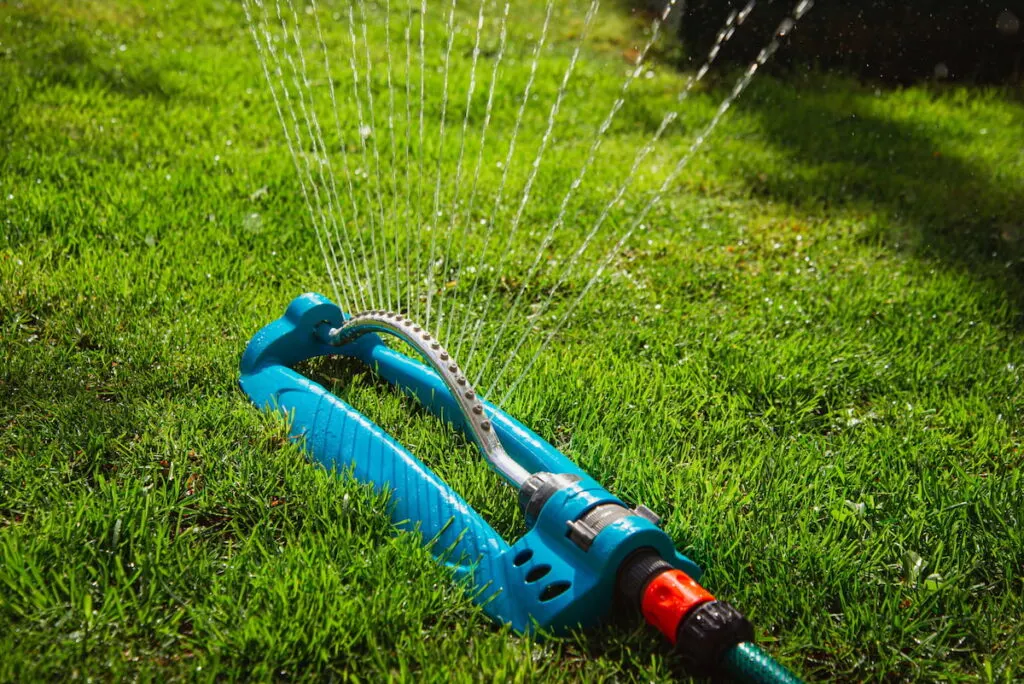
Oscillating lawn sprinklers consist of a long tube and a sprinkler head with multiple jet holes, even up to 20 holes. It relies on the pressure from the water supply to sway back and forth, in the process, covering an extensive rectangular area. You can also adjust the coverage by plugging a few holes to best suit your preferred watering space. If you have a circular lawn, then you will have some water run-off.
Most oscillating sprinklers also come with adjustment knobs that enable the gardener to adjust the pressure to find the most preferred jet distance. Additionally, it is equipped with a plastic splash guard that protects you by covering jets nearest to you while you make adjustments.
With all jet nozzles open, the oscillating sprinkler might deliver water to about 13 feet (4 meters) on both sides. However, with a few nozzles closed on both sides, the water jets might even double up the distance, making this setting ideal for slim urban lawns. It may take a little time to build the sprinkling pressure when you turn it on, but after a while, the pressure stabilizes and gets uniform.
Besides watering lawns, they can also be used by kids as summer entertainment.
3. Pop-up Sprinklers
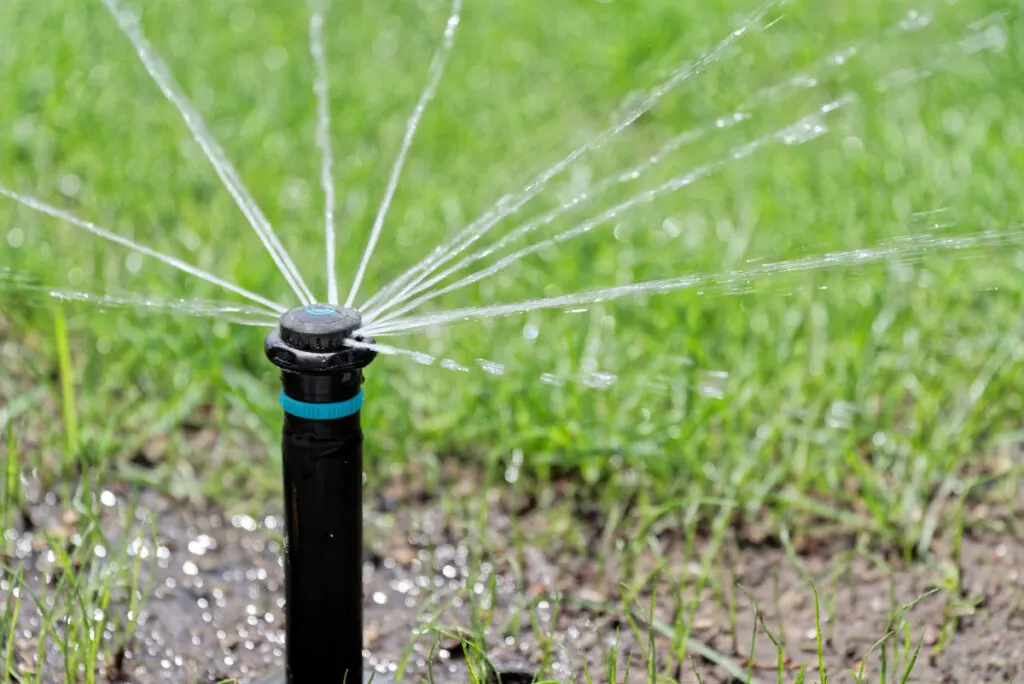
Also called in-ground sprinklers, the pop-up sprinklers are common, but are stressful and expensive to install. Either way, they are popular because of their efficiency.
Once installed, sprinklers popping on your lawn won’t bother you anymore because they “hide” underground. When the time is right, you just open the water supply valve or have a timer do this for you, and the water pressure forces it to pop out of the ground, applies the water, and after, retracts back into its housing in the ground.
The pop-up sprinkler comes fully equipped with 16 flexible and adjustable nozzles that ensure even water distribution.
Using the unit’s various knobs and wheels, you can adjust the spray width, range, and direction to best fit the spray target area.
This model is by far pleasing to use but not necessarily the best for every home. Some users may find it not to have high enough water pressure to cover all parts of the lawn.
Installing it is a bit hectic since it requires a 10-inch hole dug in the ground, alongside a trench for the hose. You should therefore try an ordinary sprinkler first to test for the reach before being disappointed and you have dug up perhaps half of the lawn. It is also best if you have a professional irrigation specialist do the installation for you.
4. Misting Sprinklers

Also known as micro-sprinklers, misting sprinklers deliver small amounts of water over small spaces. They are very economical since they deliver a small amount of water per hour, making them most suited for gardens or lawns with compacted soil.
They are also good for plants that need precise and delicate watering systems such as flower beds or freshly seeded lawns. Furthermore, they are not specific to a high-pressure water supply. They are suited for homes with low water pressure as well.
5. Travelling Sprinklers
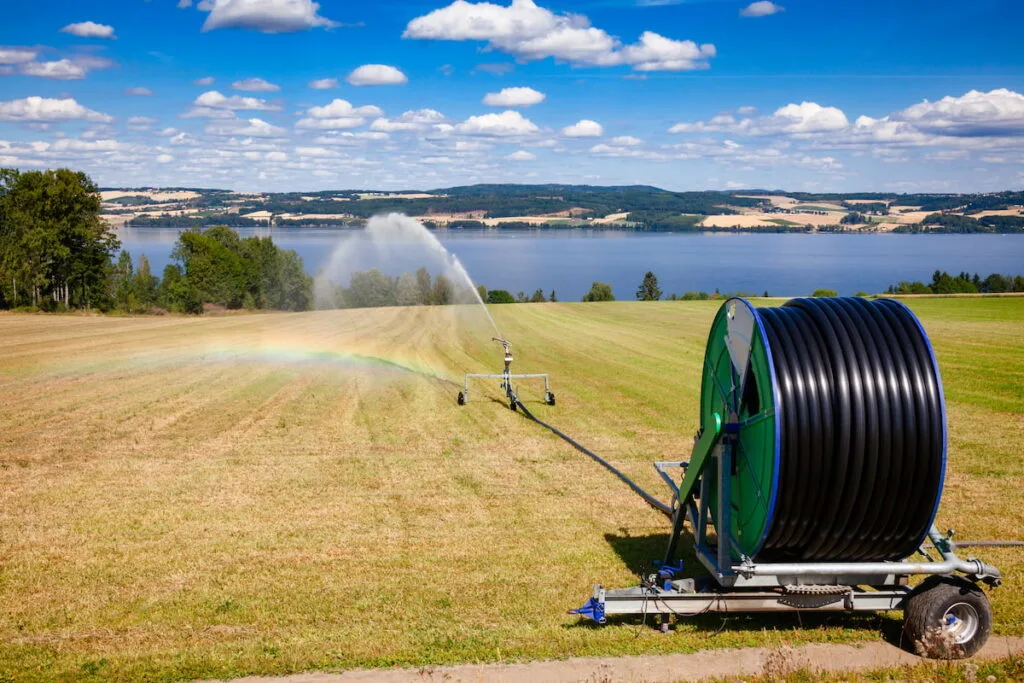
Also known as tractor sprinklers, traveling sprinklers are specialized to harness the water pressure, and use it to move around the lawn, watering as it goes. It neither needs any fossil fuels nor you to push it around.
The sprinkler travels about depending on how you arrange the hose, and automatically shuts off when they complete their routes. This implies that they can cover wide areas, including oddly shaped lawns.
For maximum efficiency, high water pressure from the supply is essential, without which, they are rendered un-operational. The water pressure propels them to travel, even up-hills or through uneven ground. Either way, it saves you the stress of moving the sprinkler about an extensive lawn space or garden to water.
They are best suited for large lawns like sports fields and farms. Just ensure that you clear obstacles like large rocks from their path.
6. Stationary Lawn Sprinklers
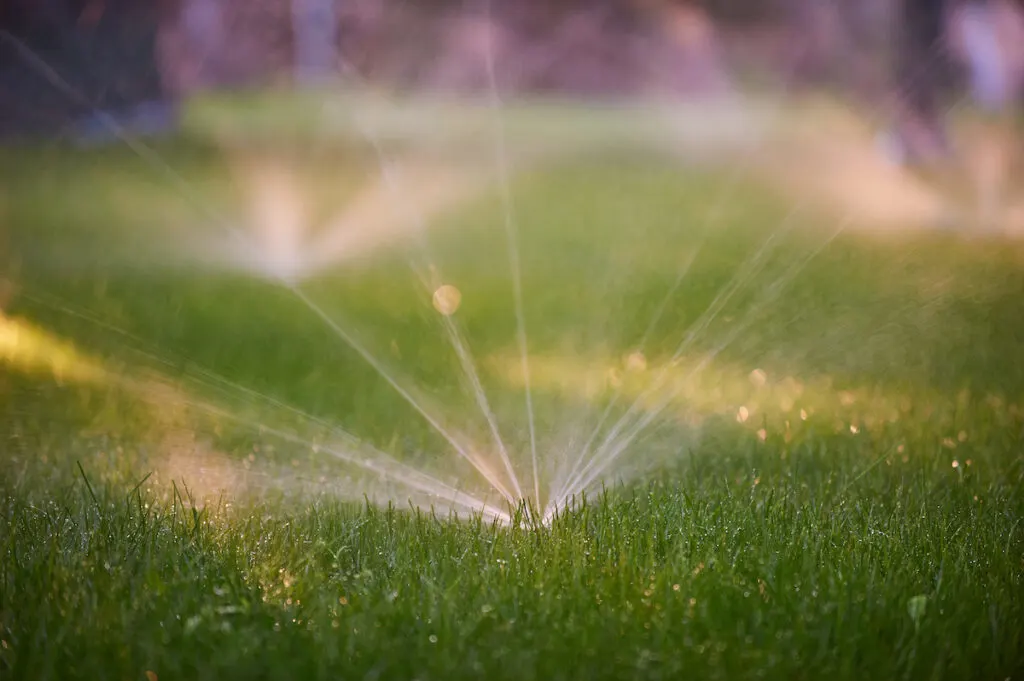
These are fixed lawn sprinklers that have water jets spraying in particular patterns to the same direction but can be adjusted to spray in half or full circle. While some are known to spray to over 17 feet, most have weaker jets and spray no more than 15 feet in either direction.
Compared to rotary sprinklers, fixed sprinklers do not pack much pressure, and can only spray smaller areas at a time, making them most suited for small and medium-sized lawns. They also work well with low water pressure, although low pressure directly reduces the distance of the jet.
They are best suited for lawn spaces with straight edges since they can be put to face inside at one straight edge and switched to spray in a half a circle. However, unless you have a small lawn, you might have to move the sprinkler a couple of times around the lawn.
7. Sprinkler Hose
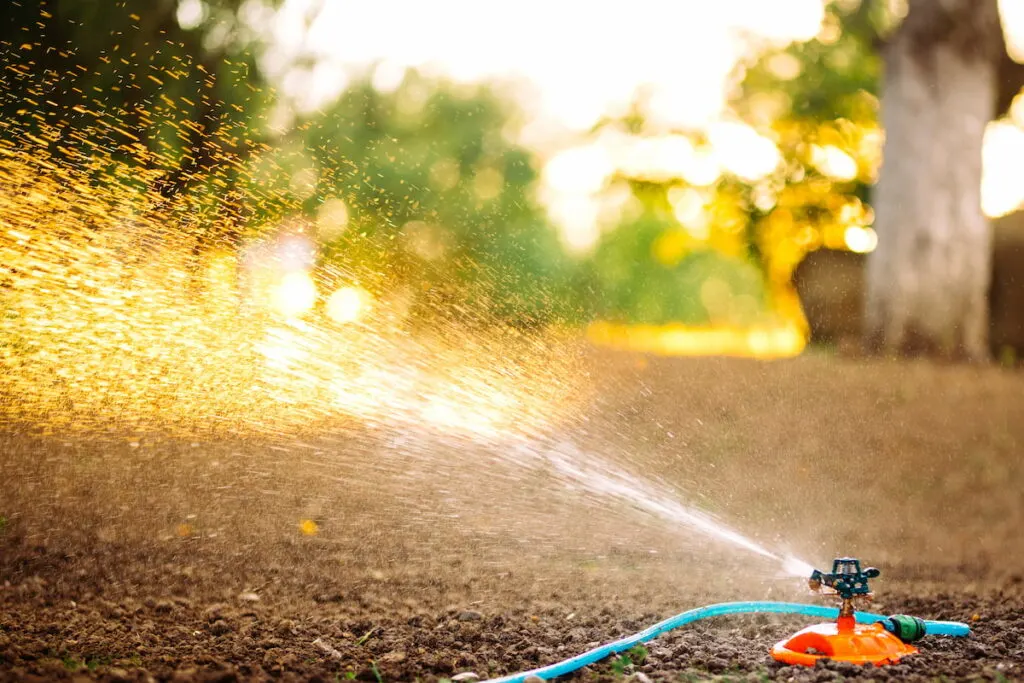
This is a set blend of hoses and sprinklers, and some might say they are not exactly sprinkler systems. Here, the sprinklers are attached to the hoses and can either be manually sprayed across the lawn or set at an angle to spray small spaces.
Sprinkler hoses do not have high pressure and are most suitable for watering small lawn spaces, or most preferably, flower beds or potted plants.
Best Sprinklers for Various Situations
Depending on the landscape, some sprinklers are better employed than others. Let’s find out.
- Large lawn – Impact sprinklers are best suited since you can space them far apart, and need fewer sprinklers. Traveling sprinklers are also ideal for large spaces.
- Long and narrow lawn patches – Rotary sprinklers are best suited since the arc can be adjusted to avoid spraying the sideways.
- Curved edges – Stationary sprinklers with arcs set to a half-circle are best positioned at the curved corners facing the lawn. You can use other sprinklers like rotary sprinklers elsewhere on the lawn.
- Windy Locations – rotary sprinklers are best suited for windy locations because the high pressures are possibly equal to or higher than the wind pressure.
- Low-pressure water supply – use spray heads, fixed sprinklers, or gear-driven rotary sprinklers if the pressure at the water supply is less than 50 psi.
- Small patch of lawn – a spray head adjusted to a full circle arc is best for secluded small lawns.
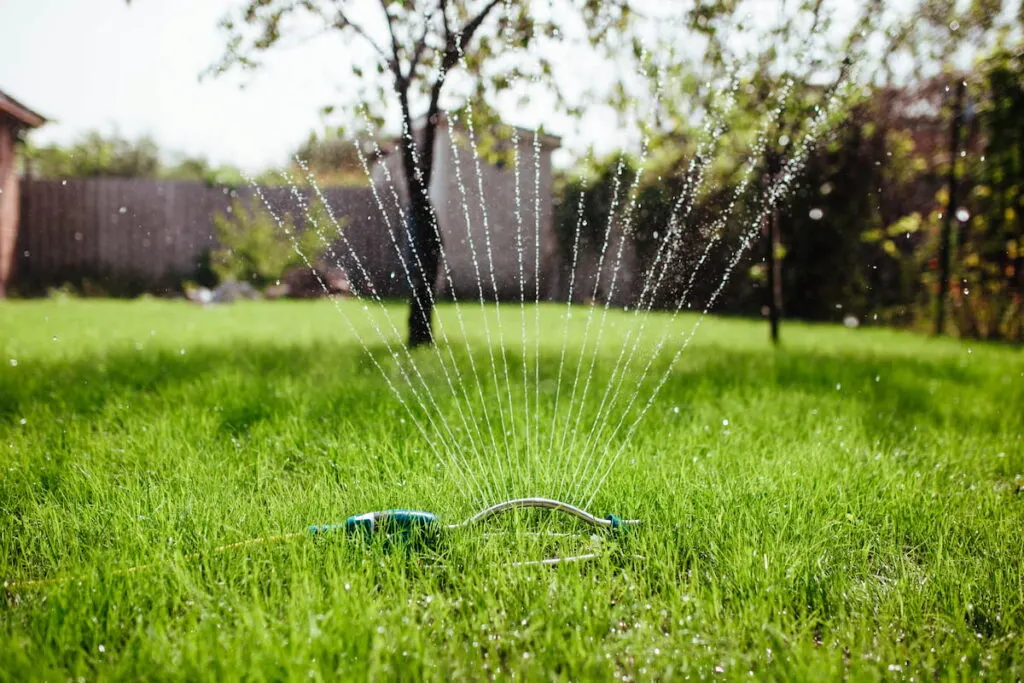
Conclusion
Among other things, the type of sprinkler you choose will determine the amount of water you apply, and the extra work you put in.
The cost of acquisition and installation greatly varies depending on the type of sprinkler. Depending on your level of expertise, you can install the sprinklers yourself, but you should consult or seek professional guidance from qualified landscapers.
Resources
- https://www.t3.com/features/best-lawn-sprinkler
- https://fogco.com/differences-between-water-spray-systems-sprinklers-and-water-mist-systems
- https://www.igra-world.com/types-of-lawn-sprinklers
- https://www.familyhandyman.com/list/find-the-best-sprinkler-for-your-yard
- https://www.hunker.com/13729102/x-best-lawn-sprinklers-for-every-yard-area
- https://edenapp.com/blog/what-are-the-different-types-of-lawn-sprinklers
- https://www.expertreviews.co.uk/garden/1413542/best-garden-sprinklers
